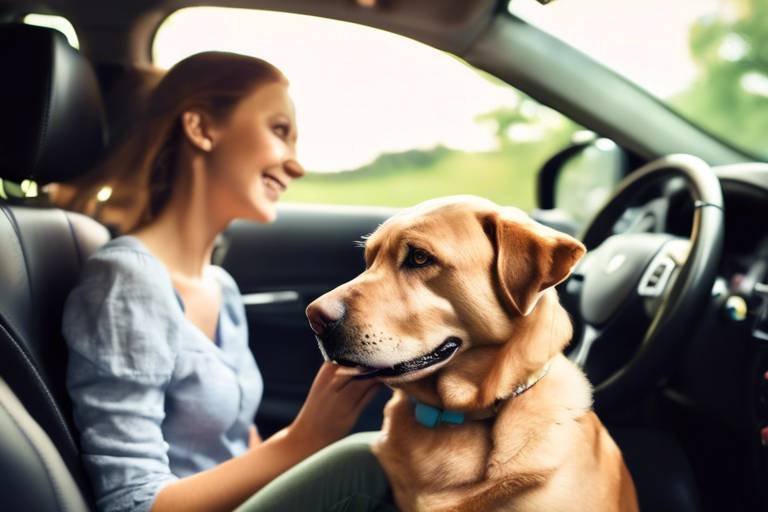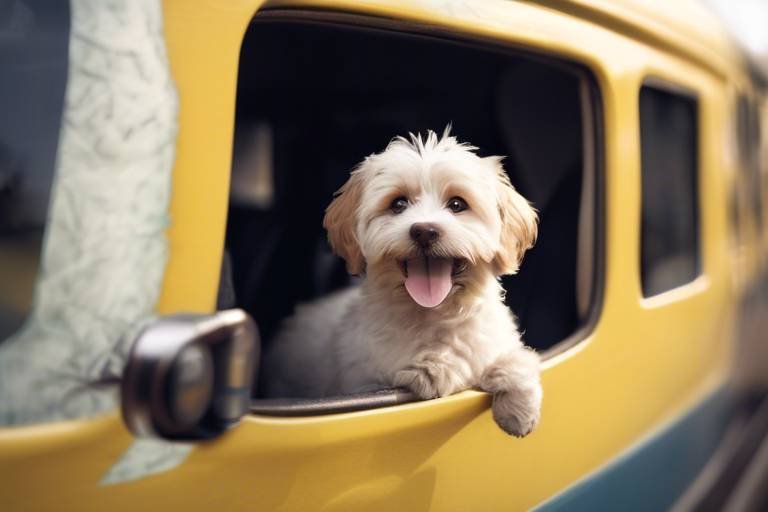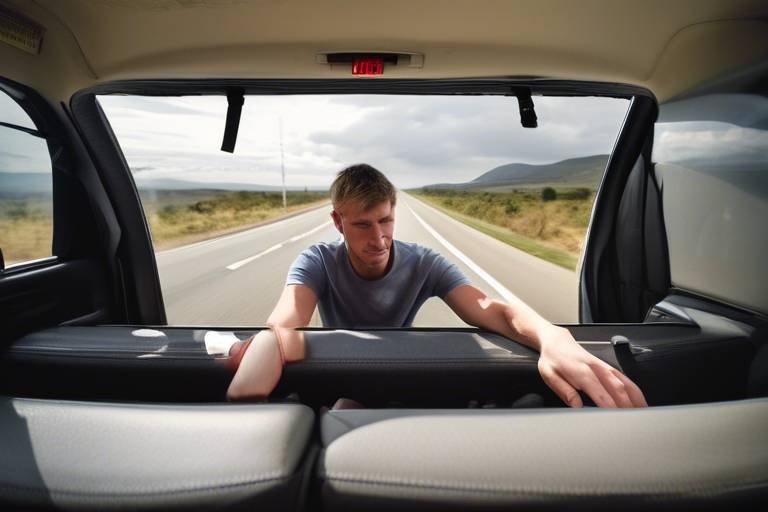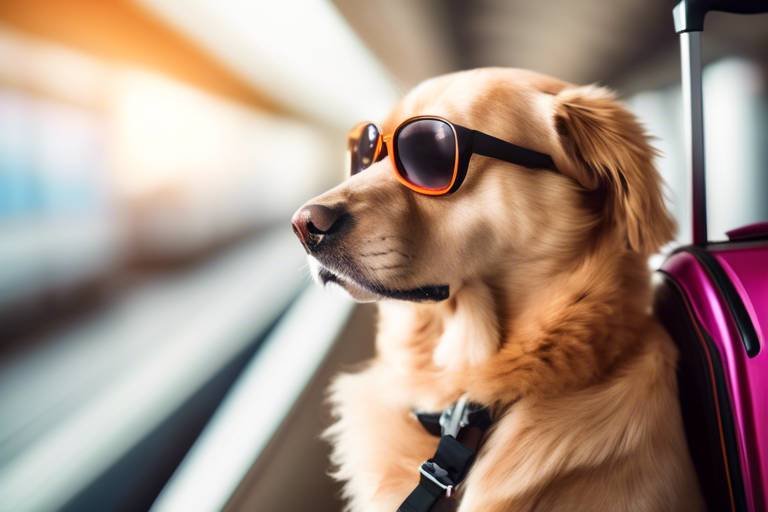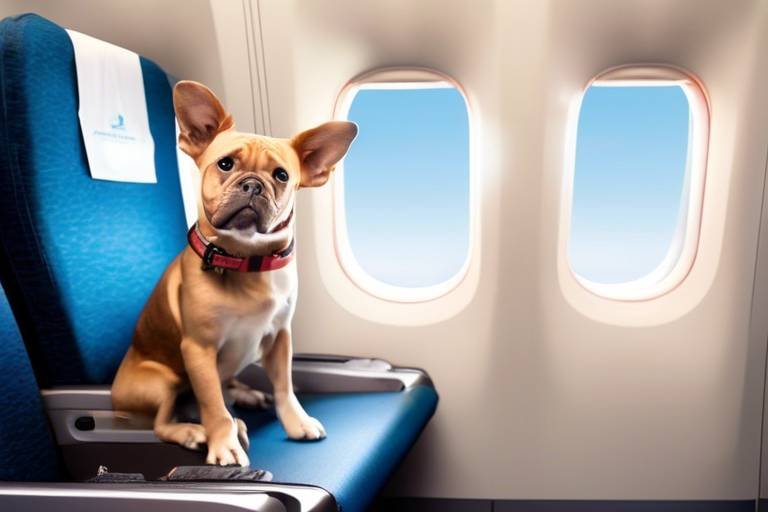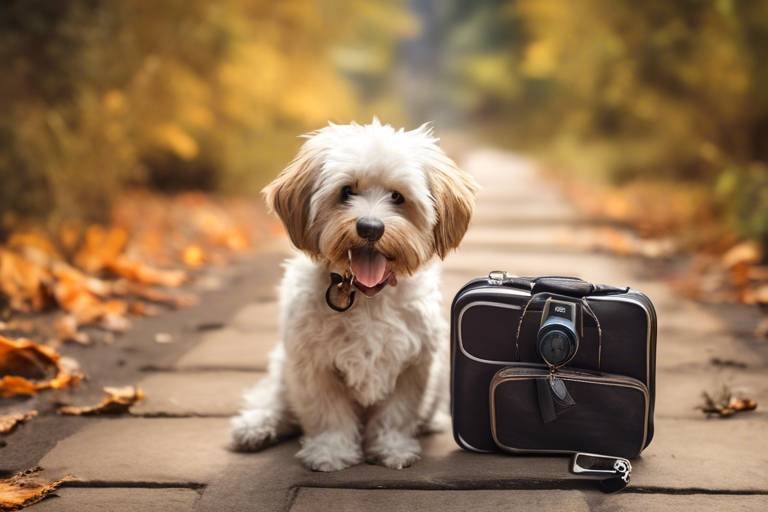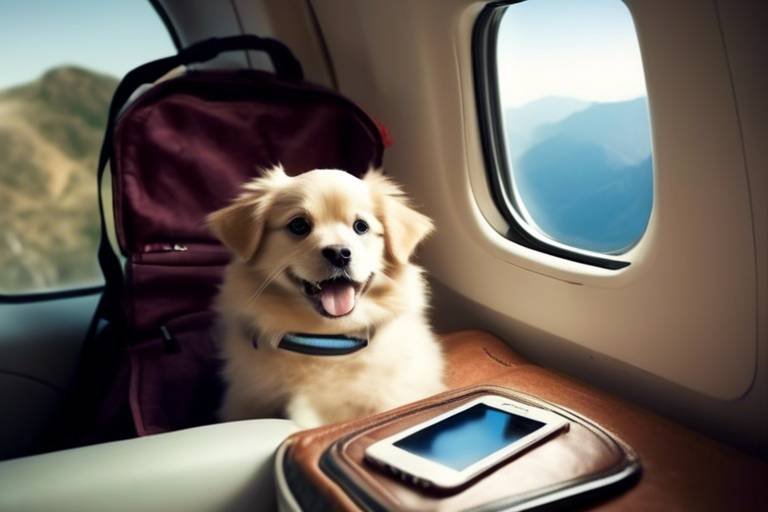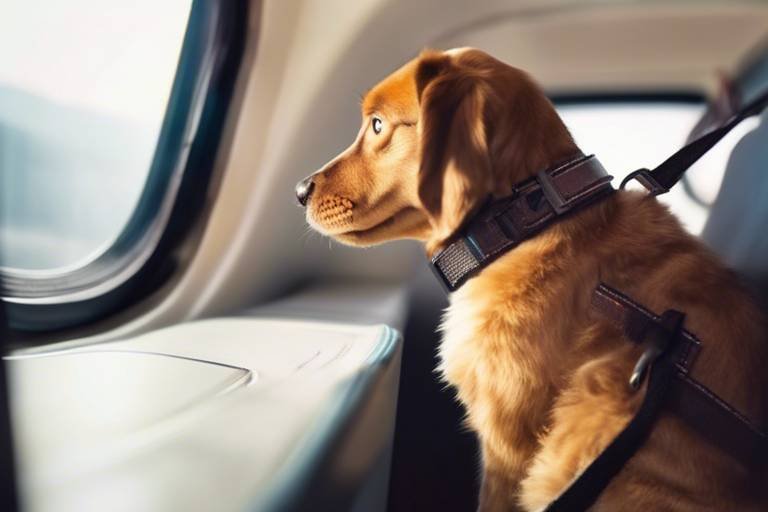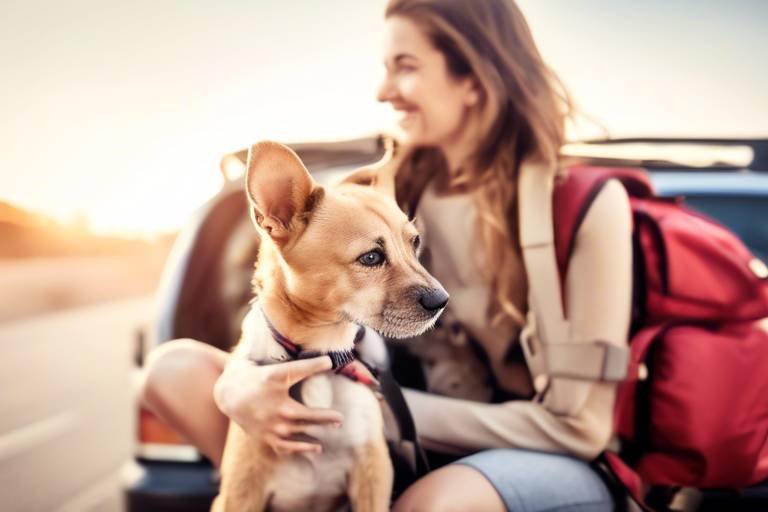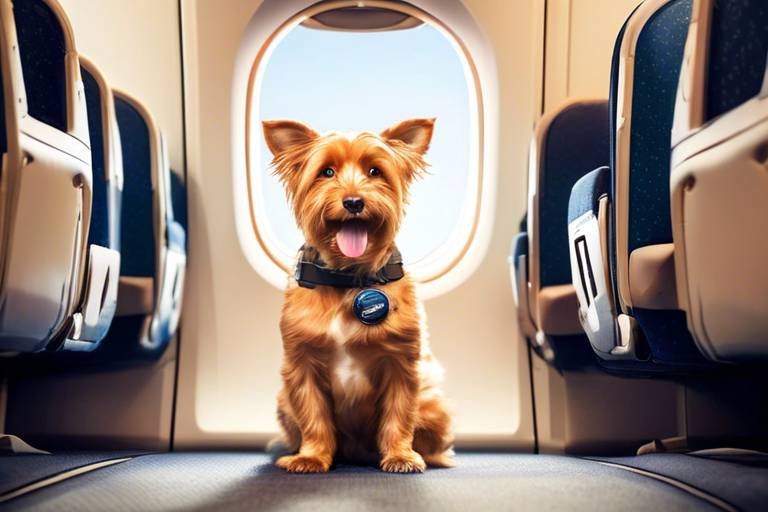How to Ensure Pet Safety in the Car
Traveling with your furry friend can be one of the most rewarding experiences, but it also comes with a hefty responsibility: ensuring their safety in the car. Imagine cruising down the highway with your dog’s ears flapping in the wind, or your cat peacefully curled up in a cozy carrier. Sounds delightful, right? However, without proper precautions, that joy can quickly turn into a nightmare. In this article, we’ll explore essential tips and precautions that every pet owner should consider to keep their beloved companions safe while on the road. From understanding pet restraint systems to choosing the right travel gear, we’ve got you covered!
When it comes to pet safety in the car, restraint systems are not just a luxury; they are a necessity. Think of them as the seat belts of the pet world. Just like you wouldn’t drive without buckling up, your pets need to be secured too! There are several types of restraint systems available, each with its own unique benefits. Let’s take a closer look at some of the most popular options:
- Harnesses: These are designed to attach to your car's seat belt system. They keep your pet secure while allowing them to sit or lie down comfortably.
- Crates: Crates provide a safe, enclosed space for your pet during travel. They can be especially beneficial for anxious pets.
- Seat Belts: Specially designed pet seat belts can be clipped onto a harness, keeping your pet safe and preventing them from roaming around the vehicle.
Using these systems not only protects your pet but also minimizes distractions for the driver, making for a safer trip for everyone involved.
Now that we’ve covered pet restraint systems, let’s talk about travel gear. The right gear can make all the difference in ensuring your pet's comfort and safety during car journeys. Think of it as packing for a mini-vacation for your pet! Here are some essentials to consider:
- Carriers: If you have a smaller pet, a sturdy carrier can provide a safe space while also being easy to transport.
- Blankets: A familiar blanket can help soothe your pet, making them feel at home even in a moving vehicle.
- Seat Covers: Protect your car’s interior with seat covers designed for pets. They can help prevent hair and scratches while keeping your pet secure.
Choosing the right travel gear not only enhances your pet's comfort but also ensures their safety during the ride. It’s a win-win situation!
Crate training is not just for house training; it can also facilitate safer travel experiences for your pet. A well-trained pet will feel secure in their crate, reducing anxiety and making the journey smoother. Imagine your pet being able to relax in their own space while you focus on the road. It’s like having a little travel buddy who knows how to behave!
When selecting a crate, size matters! You want to ensure that your pet has enough space to sit, stand, and lie down comfortably. A crate that’s too small can cause distress, while one that’s too large may not provide the sense of security they need. A good rule of thumb is to measure your pet's height and length and choose a crate that allows for some extra room.
Not all crates are created equal! When shopping for a crate, look for important safety features such as:
- Ventilation: Good airflow is crucial for your pet's comfort.
- Durability: Ensure the crate is made from strong materials that can withstand any potential mishaps.
- Secure Locking Mechanisms: A crate that can be easily opened by your pet is a recipe for disaster!
By investing in a quality crate with these features, you can rest assured that your pet will be safe and secure during your travels.
Pet seat belts are another fantastic option for keeping your furry friend safe in the car. They function similarly to human seat belts, attaching to a harness and preventing your pet from moving around too much. This not only protects your pet but also keeps them from becoming a distraction while you’re driving. Imagine the peace of mind knowing your pet is secure, allowing you to focus on the road ahead!
Before hitting the road, it’s essential to consider your pet's health. Just like humans, pets can experience stress and discomfort during travel. Scheduling a pre-trip veterinary checkup can help ensure your pet is healthy and up-to-date on vaccinations. It’s like giving your pet a health passport for their travel adventure!
Scheduling a veterinary visit before long trips is crucial. Your vet can check for any underlying health issues and ensure your pet is fit for travel. Additionally, they can provide you with important information regarding vaccinations and medications. After all, you wouldn’t want to be on the road with a pet that’s feeling under the weather!
It’s not uncommon for pets to experience motion sickness during car rides. If your pet seems restless or nauseous, it’s essential to recognize the signs early. Some strategies for managing motion sickness include:
- Gradually acclimating your pet to car rides.
- Using calming aids or medications prescribed by your veterinarian.
- Taking frequent breaks during long trips to allow your pet to stretch and relieve themselves.
By being proactive about managing motion sickness, you can make travel more comfortable for your pet and ensure a smoother ride for everyone.
Q: Is it safe to let my pet roam free in the car?
A: No, allowing your pet to roam free can be dangerous for both the pet and the driver. Always use a restraint system.
Q: What should I do if my pet gets anxious during travel?
A: Consider using calming products or consult your vet for advice on managing anxiety.
Q: How often should I take breaks during long trips?
A: Aim to take a break every 2-3 hours to allow your pet to stretch, hydrate, and relieve themselves.

Understanding Pet Restraint Systems
When it comes to traveling with your furry friend, ensuring their safety in the car is paramount. Just like we buckle up for safety, our pets deserve the same level of protection. Pet restraint systems are specifically designed to keep our beloved companions secure during car rides, minimizing distractions for the driver and reducing the risk of injury in the event of an accident. There are several types of restraint systems available, each with its unique features and benefits. Let's dive into the key options!
One of the most popular options is the harness. These are not just any harnesses; they are specially designed for car safety. A good pet harness attaches to the car's seat belt system, allowing your pet to sit or lie down comfortably while keeping them restrained. This is particularly beneficial for dogs who love to move around, as it prevents them from jumping into the front seat or distracting the driver. When choosing a harness, look for one that is crash-tested and made from durable materials.
Another great option is the pet crate. Crates provide a secure environment for pets, especially during long trips. They can help your pet feel more at ease, as many animals view their crate as a safe haven. Plus, crates can be easily secured in the vehicle, ensuring that your pet remains in one spot. When using a crate, it's essential to select the right size; your pet should be able to sit, stand, and turn around comfortably. A cramped crate can cause anxiety and discomfort, which is the last thing you want during a road trip.
Lastly, we have pet seat belts. These innovative devices attach directly to your pet's harness and plug into the car's seat belt system. They are incredibly easy to use and can be a great option for short trips. Pet seat belts allow your pet to move a bit while still keeping them secure, which is perfect for pets who enjoy looking out the window. However, it’s crucial to ensure that the seat belt is compatible with your pet's harness to prevent any accidents.
To summarize, understanding the various pet restraint systems available is essential for any pet owner. Whether you choose a harness, crate, or seat belt, the goal is the same: to keep your pet safe and secure while on the road. Remember, just as you wouldn’t drive without wearing a seatbelt, your pet deserves the same consideration. By investing in a reliable restraint system, you’re not only protecting your furry friend but also ensuring a smoother, safer ride for everyone in the vehicle.

Choosing the Right Travel Gear
When it comes to ensuring your furry friend’s safety and comfort during car rides, choosing the right travel gear is absolutely crucial. Think of travel gear as the armor that protects your pet while on the road. Just like you wouldn’t embark on a long journey without ensuring your own comfort and safety, your pet deserves the same level of consideration. From carriers to blankets, the right gear can make all the difference. So, what should you consider when selecting travel gear for your pet?
First off, let’s talk about carriers. Depending on the size of your pet, a sturdy, well-ventilated carrier can provide a safe space for them to relax while you navigate the open road. It’s important to choose a carrier that is not only durable but also easy to secure in your vehicle. Look for carriers that have a secure locking mechanism and are made from materials that can withstand a bit of wear and tear. If your pet is prone to anxiety, consider carriers that offer a cozy, enclosed space where they can feel secure.
Next on the list is the ever-important blanket. A familiar blanket can provide comfort and a sense of security for your pet during travel. It’s like bringing a piece of home along for the ride! Not only does it keep them cozy, but it also protects your car seats from pet hair and potential messes. Choose a blanket that is easy to wash, as road trips can sometimes lead to unexpected spills or accidents.
Don’t forget about seat covers! These handy accessories can protect your car’s interior from scratches, fur, and dirt. They are especially useful if your pet loves to jump around or if you’re traveling with more than one furry friend. Look for seat covers that are waterproof and easy to install, as well as those that can be easily cleaned after your trip. A good seat cover can transform your car into a pet-friendly zone while keeping it looking sharp.
Now, let’s not overlook the importance of restraint systems. Whether you opt for a pet seat belt or a harness, having a way to secure your pet during travel is vital. Restraint systems not only keep your pet safe in case of sudden stops but also minimize distractions for the driver. It’s like having an extra set of hands to help keep your pet calm and collected while you focus on the road ahead.
In summary, choosing the right travel gear involves selecting items that ensure your pet's comfort, safety, and security. The right combination of carriers, blankets, seat covers, and restraint systems can make your travels more enjoyable for both you and your furry companion. So, before you hit the road, take the time to gather the essential gear that will help create a positive travel experience for everyone involved.
Q: What type of carrier is best for my dog?
A: The best carrier depends on your dog's size and temperament. Look for one that is spacious, well-ventilated, and secure. If your dog is anxious, a cozy, enclosed carrier might be best.
Q: How can I prevent my pet from getting car sick?
A: To prevent motion sickness, try to avoid feeding your pet right before a trip. Gradually acclimate them to car rides and consider consulting your vet for medication if necessary.
Q: Are pet seat belts safe?
A: Yes! Pet seat belts are designed to keep your pet secure in the car, reducing the risk of injury during sudden stops or accidents. Just make sure to choose a high-quality, crash-tested product.
Benefits of Crate Training
Crate training is often viewed as a method of confinement, but in reality, it serves as a powerful tool for ensuring your pet's safety during car travels. Imagine your furry friend nestled comfortably in a crate, feeling secure and protected, rather than bouncing around the backseat like a pinball. This is just one of the many benefits of crate training that can enhance your travel experiences.
One of the primary advantages of crate training is that it provides your pet with a safe haven. Dogs and cats are creatures of habit, and a crate can serve as their personal space, much like a cozy den. When you’re on the road, this familiar environment can help alleviate anxiety and stress, making the journey smoother for both you and your pet. It’s akin to having a mini home on wheels, where your pet can retreat to when the world outside gets a bit too overwhelming.
Moreover, a crate can help minimize distractions while you’re driving. We all know how tempting it can be for pets to jump into the front seat or stick their heads out the window. With a crate, you can keep your pet securely in place, allowing you to focus on the road without worrying about sudden interruptions. This not only enhances the safety of your pet but also that of all passengers in the vehicle.
In addition to safety, crate training can also be beneficial for housebreaking. When you travel, maintaining your pet's routine is crucial. A crate can help reinforce the idea that it’s time to hold it until you reach your next stop. This is especially important during long road trips where restroom breaks may be spread out. By using a crate, you can establish a reliable routine that helps keep your pet comfortable and reduces the risk of accidents in the car.
Furthermore, a well-trained pet is often more welcome in various environments. Many hotels and accommodations are pet-friendly, but they often require pets to be crated when left alone in the room. Crate training ensures that your pet is accustomed to being in a crate, making it easier for you to enjoy your travels without worrying about your pet’s behavior.
In summary, crate training offers a multitude of benefits for both pets and their owners during car travel. It creates a secure environment, minimizes distractions, aids in housebreaking, and makes your pet more adaptable to different settings. So, if you haven’t already, consider investing some time into crate training your furry companion. It’s not just about keeping them confined; it’s about providing them with a safe space that enhances their travel experience.
- Is crate training cruel for pets? No, when done correctly, crate training provides pets with a safe and comfortable space, not a punishment.
- How long can a pet stay in a crate during travel? Generally, pets should not be crated for more than a few hours at a time, and regular breaks should be taken during long trips.
- What if my pet doesn’t like the crate? Gradually acclimate your pet to the crate by making it a positive space with treats and toys.
Choosing the Right Crate Size
When it comes to ensuring your furry friend’s safety and comfort during car rides, selecting the right crate size is absolutely crucial. Imagine trying to squeeze into a seat that’s either too small or too large for you—it’s uncomfortable and downright frustrating! The same principle applies to your pet’s travel crate. A crate that is too small can make your pet feel cramped and anxious, while one that is too large may cause them to slide around, which can be dangerous during sudden stops or turns.
To choose the perfect crate size, start by measuring your pet. You’ll want to take into account their height and length when they are standing and lying down. A good rule of thumb is to add a few inches to these measurements to ensure they have enough room to sit up, turn around, and lie down comfortably. Here’s a simple formula to follow:
| Pet Size | Recommended Crate Size |
|---|---|
| Small (up to 25 lbs) | 24" - 30" |
| Medium (26 - 50 lbs) | 30" - 36" |
| Large (51 - 90 lbs) | 36" - 42" |
| Extra Large (over 90 lbs) | 42" - 48" |
After determining the right dimensions, consider the crate’s design and material. A sturdy, well-ventilated crate not only keeps your pet comfortable but also ensures their safety. Look for crates with secure locking mechanisms and durable construction. Remember, a crate isn’t just a travel tool; it’s a safe haven for your pet. They should feel secure and protected inside, especially during bumpy rides.
Additionally, it’s beneficial to introduce your pet to the crate before your trip. This can help them associate the crate with positive experiences. You might want to place their favorite blanket or a few toys inside to make it feel more like home. A crate that feels familiar can significantly reduce anxiety during travel, making the whole experience smoother for both you and your pet.
In summary, choosing the right crate size is about more than just dimensions; it’s about ensuring your pet’s comfort and safety. A well-sized crate can transform a potentially stressful car ride into an enjoyable adventure. So, take the time to measure, choose wisely, and prepare your pet for a fun, safe journey!
Crate Safety Features
When it comes to ensuring your pet's safety during car travel, the right crate can make all the difference. Not only does it provide a secure environment for your furry friend, but it also helps minimize distractions for the driver. However, not all crates are created equal. You want to look for specific safety features that will keep your pet comfortable and secure on the road.
One of the most crucial aspects to consider is ventilation. A well-ventilated crate allows for proper airflow, ensuring that your pet remains cool and comfortable, especially on long journeys. Look for crates that have multiple ventilation openings on all sides, as this will help maintain a fresh atmosphere inside the crate.
Another important feature is durability. Your pet's crate should be constructed from high-quality materials that can withstand wear and tear. A durable crate is not only more secure but also provides peace of mind knowing that it can handle any bumps along the road. Consider crates made from heavy-duty plastic or metal, as they tend to be more robust than those made from flimsy materials.
Equally vital is the locking mechanism. A secure locking system is essential to prevent your pet from accidentally escaping during travel. Look for crates with robust latches and locks that are easy for you to operate but difficult for your pet to manipulate. This feature is especially important if your pet is known for being a little too curious!
Additionally, you should also consider the crate size. A crate that is too small can cause discomfort, while one that is too large may not provide the sense of security that your pet craves. The ideal crate should allow your pet to sit, stand, and lie down comfortably without excessive room to move around. This balance helps to keep them calm and secure during the ride.
Lastly, look for crates that come with removable and washable liners. Accidents can happen, and having a crate that is easy to clean can save you a lot of hassle. A removable liner can be quickly taken out and washed, ensuring that your pet has a clean and hygienic space to relax during your travels.
In summary, when selecting a crate for your pet, keep an eye out for ventilation, durability, secure locking mechanisms, appropriate size, and easy-to-clean features. These safety aspects not only enhance your pet's travel experience but also contribute to a safer journey for everyone in the vehicle. After all, a happy pet means a happy trip!
- What size crate should I choose for my pet? The crate should allow your pet to sit, stand, and lie down comfortably without too much extra space.
- How can I ensure my pet is comfortable in the crate during travel? Use soft bedding, ensure proper ventilation, and take breaks during long trips to let them stretch.
- Are there any specific brands known for safe pet crates? Yes, brands like Petmate, MidWest Homes, and Variocage are known for their quality and safety features.
Using Pet Seat Belts
When it comes to ensuring your furry friend's safety during car rides, pet seat belts are a game changer. Just like humans buckle up for protection, your pets deserve the same level of security. Imagine driving down the highway, and suddenly having to brake hard; without a seat belt, your pet could become a projectile, potentially causing harm to themselves and everyone else in the car. That's where pet seat belts come into play, acting as a crucial line of defense.
So, how do these nifty inventions work? Pet seat belts are designed to attach to your pet's harness and clip into your car's seat belt system. This setup not only keeps your pet secure but also allows them some freedom to move around without being a distraction. It's like giving your pet their own little cozy space while ensuring they stay put. Just picture your dog happily looking out the window, safely restrained, instead of bouncing around the backseat!
One of the biggest advantages of using pet seat belts is the reduction of distractions for the driver. A pet that’s roaming freely can easily become a source of chaos—think of a cat darting across your lap or a dog trying to stick their head out of the window. By using a seat belt, you can focus on the road ahead, knowing your pet is safely secured. Plus, many pet seat belts are designed with safety features that minimize the risk of injury in the event of an accident.
Not all pet seat belts are created equal, though. When choosing one, consider the following factors:
- Compatibility: Ensure the seat belt fits your specific car model and works well with your pet's harness.
- Durability: Look for materials that can withstand wear and tear, especially if your pet is a chewer.
- Ease of Use: Choose a seat belt that is easy to attach and detach, making travel hassle-free.
In conclusion, using pet seat belts is not just a recommendation; it's a necessity for responsible pet owners. It enhances safety for your pet and everyone else in the vehicle, making your travels more enjoyable and worry-free. So, the next time you hit the road, remember to buckle up your furry friend!

Health Considerations for Traveling Pets
When planning a road trip with your furry friend, it's crucial to prioritize their health and well-being. Just like us, pets can experience stress and discomfort during travel, which can lead to various health issues. Before you hit the road, consider scheduling a pre-travel veterinary checkup. This visit is essential to ensure that your pet is healthy enough for the journey ahead. Not only will your vet check for any underlying health conditions, but they can also make sure that your pet is up-to-date on vaccinations and medications. This is particularly important if you're traveling to areas where certain diseases are more prevalent.
In addition to the vet visit, it's wise to discuss any specific health concerns with your veterinarian. For instance, some pets may be prone to anxiety during travel, while others might have underlying conditions that could be exacerbated by the stress of a car ride. Knowing your pet's health status and potential risks can help you prepare and make necessary adjustments to your travel plans. You wouldn’t want to find yourself in a situation where your pet is uncomfortable or unwell while you're miles away from home!
Another common issue that pet owners face during travel is motion sickness. Just like humans, pets can experience nausea and vomiting when the car starts moving. Watch for signs of motion sickness, such as drooling, whining, or restlessness. If your pet has a history of motion sickness, consult your veterinarian for advice on how to manage it effectively. They may recommend anti-nausea medications or suggest strategies like gradually acclimating your pet to car rides before the big trip.
To help ease your pet's travel experience, consider the following tips:
- Keep your pet in a well-ventilated area of the car.
- Make frequent stops to allow your pet to stretch and relieve themselves.
- Provide plenty of water to keep them hydrated.
Moreover, it's essential to keep your pet's routine as normal as possible. Bring along their favorite toys, blankets, or even a piece of your clothing to provide comfort. This familiarity can help reduce anxiety and make the journey feel less daunting. Remember, a calm pet makes for a happy trip!
Lastly, be mindful of the temperature inside your vehicle. Pets can overheat quickly, especially in warm weather. Always ensure that your pet has access to fresh air and never leave them unattended in a parked car. The consequences can be dire, and it's simply not worth the risk. By taking these health considerations into account, you can ensure that your pet has a safe and enjoyable travel experience.
Q: How often should I take my pet for a veterinary checkup before traveling?
A: It's best to schedule a checkup a few weeks before your trip, allowing time for any necessary vaccinations or treatments.
Q: What should I do if my pet gets motion sickness?
A: Consult your veterinarian for advice. They may suggest medications or acclimation techniques to help your pet adjust to car rides.
Q: Can I leave my pet in the car while I run errands?
A: No, it is unsafe to leave pets in a parked car, even for a short time. Temperatures can rise quickly, leading to heatstroke.
Pre-Travel Veterinary Checkups
Before hitting the road with your furry friend, it’s crucial to schedule a pre-travel veterinary checkup. Just like we wouldn’t embark on a long journey without ensuring our car is in good shape, our pets deserve the same consideration. A visit to the vet ensures that your pet is healthy and ready for travel, and it gives you peace of mind. During this checkup, the vet will assess your pet's overall health, check for any underlying conditions, and make sure their vaccinations are up-to-date.
One of the key reasons for a pre-travel checkup is to identify any potential health issues that could arise during the trip. For instance, some pets may have hidden allergies or conditions that could flare up under the stress of travel. Your vet can provide you with vital information about how to manage these conditions while on the road. Additionally, if your pet is on any medications, this is the perfect time to discuss how to administer them during your travels.
Moreover, many states and countries have specific vaccination requirements for pets, particularly for rabies. Ensuring your pet meets these requirements before traveling can save you a lot of hassle later. It's a good idea to ask your vet for a copy of your pet's vaccination records, as you may need to present them when crossing state lines or entering certain facilities.
While you're at the vet's office, don’t hesitate to ask about any travel-related concerns. For example, if your pet has a history of anxiety during car rides, your vet might recommend some calming solutions or medications to help ease their nerves. Remember, a little preparation goes a long way in ensuring a safe and enjoyable journey for both you and your pet!
In summary, a pre-travel veterinary checkup not only helps in confirming that your pet is fit for travel but also equips you with the necessary tools and knowledge to handle any situation that may arise. So, before you pack the car and hit the open road, make that vet appointment. Your pet will thank you for it!
- How far in advance should I schedule a pre-travel checkup? It's best to schedule the checkup at least a few weeks before your trip to allow time for any necessary vaccinations or treatments.
- What should I bring to the veterinary appointment? Bring your pet's medical records, any medications they are currently taking, and a list of questions or concerns you have regarding travel.
- Can I travel with my pet if they have a chronic condition? Yes, but it's essential to discuss your plans with your veterinarian to ensure you have the right care and medications on hand.
Managing Motion Sickness
Traveling with pets can be an exciting adventure, but for some furry friends, the journey can quickly turn into a battle against motion sickness. Just like humans, pets can experience nausea and discomfort while on the road, which can lead to a stressful situation for both the pet and the owner. So, how can we help our beloved companions feel more at ease during car rides? Here are some effective strategies to recognize and manage motion sickness in pets.
First and foremost, it's essential to identify the signs of motion sickness in your pet. Common symptoms include drooling, whining, vomiting, and restlessness. If you notice any of these behaviors, it’s crucial to take action quickly. One of the best ways to prevent motion sickness is to get your pet accustomed to car rides gradually. Start with short trips around the block and slowly increase the duration as your pet becomes more comfortable.
Another effective strategy is to ensure your pet is positioned correctly in the vehicle. Keeping them in a secure crate or using a pet seat belt can help reduce their movement, which may alleviate nausea. You might also consider the placement of the pet in the car; some pets feel better when they can see out the window, while others prefer a more enclosed space. Experimenting with different positions can help you find what works best for your furry friend.
If your pet struggles with severe motion sickness, consulting your veterinarian is a wise step. They can recommend safe medications or natural remedies that can ease your pet's discomfort. Some pet owners have found success with products like ginger or special anti-nausea medications. However, always consult with a vet before administering any treatment, as they can provide personalized advice based on your pet's health history.
Here are some additional tips to help manage your pet’s motion sickness:
- Keep the car cool: A well-ventilated, cool environment can help reduce nausea.
- Limit food before travel: Avoid feeding your pet a large meal right before the trip; a light snack may be better.
- Take breaks: If you're on a long journey, make frequent stops to allow your pet to stretch and relieve themselves.
Lastly, creating a calming atmosphere in the car can make a world of difference. Bring along their favorite blanket or toy to provide a sense of familiarity. Playing soft music or using calming pheromone sprays can also help soothe your pet’s nerves. Remember, patience is key; with time and the right approach, your pet can learn to love car rides just as much as you do!
1. What are the signs of motion sickness in pets?
Common signs include drooling, whining, vomiting, and restlessness. If you notice these symptoms, it may be time to take action.
2. Can I give my pet medication for motion sickness?
Yes, consult your veterinarian for safe medications or natural remedies that can help alleviate your pet's motion sickness.
3. How can I help my pet feel more comfortable in the car?
Use a secure crate or pet seat belt, keep the car cool, take breaks during long trips, and bring familiar items like blankets or toys.
4. Should I feed my pet before a car trip?
It's best to avoid large meals right before travel. A light snack may be more suitable to prevent nausea.
5. How long does it take for a pet to get used to car rides?
Every pet is different, but gradually increasing the length of car trips can help them become more accustomed to traveling over time.
Frequently Asked Questions
- What is the best way to restrain my pet in the car?
Using a proper pet restraint system is crucial for your pet's safety. Options like harnesses, crates, or pet seat belts are effective. Each method has its advantages, but the key is to ensure your pet is securely fastened to prevent distractions while driving.
- How do I choose the right travel gear for my pet?
Selecting the right travel gear involves considering your pet's comfort and safety. Look for carriers that are well-ventilated, blankets for warmth, and seat covers to protect your car. Ensure everything is durable and easy to clean for a hassle-free travel experience.
- Is crate training necessary for traveling with pets?
Absolutely! Crate training offers a secure environment for your pet during travel. It minimizes distractions, allowing you to focus on the road. Plus, it helps your pet feel cozy and safe in an unfamiliar setting.
- What size crate should I choose for my pet?
The right crate size should allow your pet to stand, squat, and lie down comfortably. Measure your pet from nose to tail and choose a crate that provides enough space without being too large, which could compromise their security.
- What safety features should I look for in a pet crate?
When choosing a pet crate, look for features like ventilation to keep your pet comfortable, durability to withstand wear and tear, and secure locking mechanisms to prevent escapes. These features ensure a safe and comfortable journey for your furry friend.
- Are pet seat belts effective?
Yes, pet seat belts are designed to keep your pet secured and safe during car rides. They function similarly to human seat belts, preventing your pet from moving around too much, which helps reduce the risk of injury in case of sudden stops or accidents.
- What health checks should I do before traveling with my pet?
It's essential to schedule a pre-travel veterinary checkup to ensure your pet is healthy and up-to-date on vaccinations. This visit is also a good opportunity to discuss any concerns you may have about your pet's health during travel.
- How can I manage my pet's motion sickness?
Recognizing and managing motion sickness in pets can make travel more enjoyable. Consider using anti-nausea medications prescribed by your vet, and try to keep your pet's head still during the ride. Gradual acclimatization to car rides can also help.

